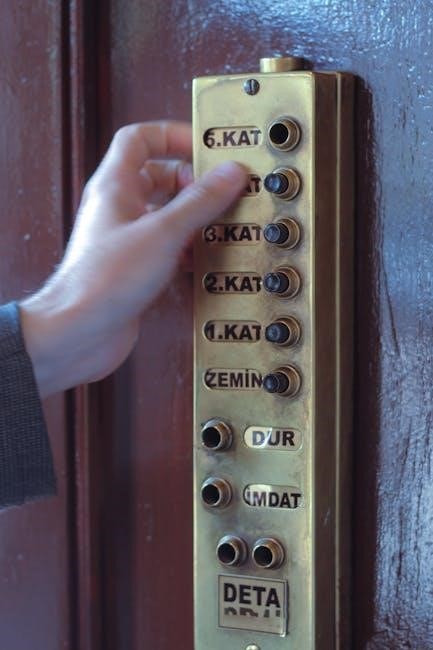hoyer lift instruction manual
Welcome to the Hoyer Lift Instruction Manual‚ your comprehensive guide to safe and effective patient lifting. This manual provides essential information for proper use‚ safety‚ and maintenance.
1.1 Overview of the Hoyer Lift
The Hoyer Lift is a medical device designed to safely transfer and lift patients‚ reducing strain on caregivers. Available in manual and electric models‚ it features a sturdy base‚ adjustable legs‚ and a spreader bar for secure patient support. The manual version uses a hydraulic pump‚ while electric models offer push-button controls for effortless operation. Key components include the mast‚ boom‚ and cradle‚ which work together to ensure smooth lifting. The lift is compatible with various slings‚ providing flexibility for different patient needs. Regular maintenance and inspection are essential to ensure optimal performance and safety. Always use genuine Hoyer parts to maintain reliability and comply with safety standards.
1.2 Importance of Following the Manual
Adhering to the Hoyer Lift Instruction Manual is crucial for ensuring patient and caregiver safety. Proper use prevents accidents and injuries‚ while incorrect operation can lead to equipment damage or harm. The manual outlines essential steps for assembly‚ maintenance‚ and operation‚ ensuring the lift functions as intended. By following guidelines‚ users can maximize the lift’s efficiency and longevity. Ignoring instructions may result in voiding warranties or compromising safety features. Always prioritize the manual’s recommendations to maintain reliability and avoid potential risks associated with misuse. Compliance with provided instructions is key to optimal performance and safe patient handling.

Safety Precautions
Always follow safety guidelines to ensure secure patient transfers. Inspect equipment before use‚ avoid overloading‚ and keep the area clear. Proper training is essential for safe operation.
2.1 General Safety Guidelines
Adhering to general safety guidelines is crucial when using a Hoyer lift. Always ensure the lift is on a firm‚ level surface and the patient is properly secured. Regularly inspect the equipment for wear or damage‚ and never exceed the maximum weight capacity. Keep the surrounding area clear of obstacles to prevent accidents. Proper training is essential for caregivers to operate the lift safely and effectively. Additionally‚ avoid using the lift in wet environments or near water‚ as this can pose electrical hazards. Always follow the manufacturer’s instructions and guidelines to ensure safe and reliable operation.
2;2 Patient Preparation and Safety
Patient preparation and safety are paramount when using a Hoyer lift. Ensure the patient is properly secured with a compatible sling‚ and their weight does not exceed the lift’s capacity; Assess the patient’s medical condition and mobility to determine the most appropriate transfer method. Always communicate clearly with the patient to reduce anxiety and ensure cooperation. Position the sling correctly under the patient‚ avoiding any pressure points or discomfort. Never leave the patient unattended while in the lift‚ and ensure the surrounding area is clear of obstacles. Proper preparation ensures a safe and dignified transfer for the patient.
2.3 Equipment Inspection Before Use
Inspecting the Hoyer lift before each use is crucial for ensuring safety and functionality. Check the hydraulic or electrical systems for any signs of damage or wear. Examine the spreader bar‚ cradle‚ and straps for integrity‚ ensuring all components are securely attached. Verify that the battery is fully charged if using an electric model‚ and test the emergency stop button to ensure it functions properly. Look for fraying or tears in slings and other fabric components. Always refer to the user manual for specific inspection guidelines. Regular inspections help prevent accidents and prolong the equipment’s lifespan‚ ensuring reliable performance during patient transfers.
2.4 Emergency Stop Button Usage
The emergency stop button is a critical safety feature on the Hoyer lift. Located on the control panel‚ it immediately halts the lift’s operation in case of an emergency; Always test the emergency stop button before use to ensure it functions correctly. Pressing the button disconnects the battery and stops all movements instantly. Use the emergency stop if the lift malfunctions‚ if there is an obstruction‚ or if the patient’s safety is at risk. After activating the emergency stop‚ carefully lower the patient to a safe position using the manual override or other specified procedures. Regularly inspect the button to ensure it is free from damage and functioning properly. Proper use of the emergency stop button is essential for preventing accidents and ensuring patient safety during transfers.

Assembly and Commissioning Instructions
Unpack the Hoyer lift carefully‚ ensuring all components are included. Position the lift in its upright position‚ unfold the mast‚ and secure the legs. Attach the spreader bar and tighten all connections firmly. Ensure the battery is charged and properly installed. Test all functions before first use to confirm proper operation. Always use genuine Hoyer parts for safety and reliability.
3.1 Unpacking and Initial Setup
Unpacking your Hoyer lift requires care to ensure all components are accounted for. Begin by carefully opening the carton and inspecting the contents for any visible damage. Remove the lift from its storage position and unfold it according to the manufacturer’s instructions. Position the lift in an upright stance and ensure the mast is fully extended. Secure the legs in the open position to maintain stability. Attach the spreader bar to the mast‚ ensuring it is firmly locked in place. Install the battery pack into the control box‚ making sure it is properly connected. Double-check all connections and components before proceeding to the next steps. If any parts are missing or damaged‚ contact your supplier immediately. Always refer to the manual for specific assembly instructions tailored to your model.
3;2 Battery Charging and Installation
Proper battery charging and installation are crucial for the Hoyer lift’s operation. Begin by inserting the power supply plug into the charging port located at the base of the control box. Ensure the plug is fully connected to avoid partial charging. Charge the battery for at least 8 hours before initial use and avoid charging in damp environments like bathrooms. Once charged‚ install the battery pack securely into the designated compartment on the lift. Verify that all connections are tight and the battery is properly seated. After installation‚ test the lift’s functions to confirm it operates smoothly. Regularly check the battery level and recharge as needed to maintain optimal performance. Always use genuine Hoyer parts for safety and reliability.

Operating Instructions
Follow detailed steps for safe operation‚ including leg adjustment‚ spreader bar alignment‚ and patient lifting. Ensure all functions are tested before use for smooth transitions and patient safety.
4.1 Leg Adjustment for Stability
Proper leg adjustment is critical for ensuring the stability of the Hoyer Lift during operation. Begin by positioning the lift on a firm‚ level surface. Open the legs to the desired width using the adjustment mechanism‚ ensuring the base remains balanced. For models like the Hoyer Advance‚ engage the leg-locking knob securely to prevent movement. Always verify that the legs are fully locked before proceeding. If the lift is used near obstacles‚ such as armchairs or wheelchairs‚ adjust the leg width accordingly for optimal access. Regularly inspect the leg locking mechanism to ensure it functions correctly. Stability is key to safe patient transfers‚ so double-check the setup before raising or lowering the patient.
4.2 Spreader Bar and Cradle Operation
The spreader bar and cradle are essential components of the Hoyer Lift‚ ensuring secure and balanced patient support. To operate‚ attach the sling to the spreader bar‚ making sure all straps are securely connected. Position the spreader bar over the cradle‚ aligning it with the mast. Gently lower the mast until the spreader bar clicks into place. Always ensure the cradle is properly seated to prevent any shifting during use. Before lifting‚ double-check that the spreader bar is evenly balanced and the sling is taut. Regularly inspect the spreader bar and cradle for wear or damage. Proper operation ensures safe and smooth patient transfers‚ minimizing the risk of accidents.
4.3 Raising and Lowering the Patient
Raising and lowering the patient with a Hoyer Lift requires careful attention to ensure safety and comfort; Begin by ensuring the sling is properly secured and the spreader bar is balanced. For manual lifts‚ slowly pump the hydraulic handle to raise the patient‚ maintaining stability. For powered lifts‚ use the hand control to initiate movement. Always operate at a steady‚ controlled pace‚ avoiding sudden jerks. When lowering‚ reduce the height gradually‚ ensuring the patient remains centered. Keep communication with the patient to reassure them and adjust positioning as needed. Never leave the patient unattended while in the lift. Regularly inspect the lift’s hydraulic or electrical systems to ensure smooth operation and patient safety. Proper technique minimizes risks and ensures a secure transfer process.

Maintenance and Inspection
Regularly inspect the Hoyer Lift‚ including spreader bars‚ hydraulic units‚ and sling attachments. Ensure all components are secure and functioning properly. Follow a scheduled maintenance plan for optimal performance and safety.
5.1 Regular Maintenance Schedule
A regular maintenance schedule ensures the Hoyer Lift operates safely and efficiently. Inspect the spreader bar‚ hydraulic unit‚ and battery every 6 months. Check for wear on moving parts and ensure all bolts are secure. Clean the lift regularly to prevent dirt buildup. For electric models‚ charge batteries fully after each use and avoid overcharging. Hydraulic models should have fluid levels checked annually. Always use genuine Hoyer parts for replacements to maintain warranty and safety standards. Keep a log of maintenance activities for future reference. This routine will extend the lift’s lifespan and ensure reliable performance.
5.2 Inspection of Key Components
Regular inspection of key components is crucial for ensuring the Hoyer Lift’s safe and effective operation. Check the spreader bar for proper rotation and wear on the central pivot. Inspect the hydraulic unit for leaks and ensure all connections are secure. For electric models‚ examine the battery and charging system for damage or corrosion. Verify the mast is fully locked in place and the boom is securely attached. Inspect slings for fraying‚ tears‚ or excessive wear. Ensure the emergency stop button functions correctly and the hand control is responsive. Document all findings and address any issues promptly to maintain safety and performance. Always refer to the manual for specific inspection guidelines.

Troubleshooting Common Issues
- Address hydraulic or electrical failures by checking fluid levels and connections.
- Resolve spreader bar malfunctions by ensuring proper alignment and lubrication.
- Test the emergency stop button regularly to ensure proper functionality.
6.1 Addressing Hydraulic or Electrical Failures
Hydraulic or electrical failures in a Hoyer Lift require immediate attention to ensure patient safety. Common issues include reduced lifting power‚ slow operation‚ or complete system shutdown. Always disconnect the power source before inspecting the lift. For hydraulic systems‚ check fluid levels and look for signs of leakage. Ensure all connections are secure and free from corrosion. For electrical failures‚ inspect the battery‚ charging port‚ and control box for damage or loose connections. If the issue persists‚ consult a professional technician. Regular maintenance‚ such as lubricating moving parts and updating software‚ can prevent such failures. Always follow the manufacturer’s guidelines for troubleshooting and repairs to ensure optimal performance and safety.
6.2 Resolving Spreader Bar Malfunctions
Malfunctions with the spreader bar can disrupt safe patient transfers. If the spreader bar fails to rotate or detach‚ stop using the lift immediately. Inspect for obstructions or tight connections. Lubricate hinges and joints to ensure smooth movement. Check the retaining cradle for proper alignment and secure locking. If the issue persists‚ consult the user manual or contact a certified technician. Regular maintenance‚ such as cleaning and inspecting the spreader bar‚ can prevent malfunctions. Always ensure all components are functioning correctly before attempting any patient lift to guarantee safety and reliability. Proper handling and storage of the spreader bar are also crucial to maintain its effectiveness and longevity.

Accessories and Slings
The Hoyer Lift supports various accessories‚ including slings designed for different patient needs. Slings must be checked regularly for wear and tear‚ ensuring safety and comfort.
7.1 Types of Slings and Their Usage
Hoyer Lifts utilize various slings tailored for specific patient requirements. The universal sling is ideal for general transfers‚ offering maximum support. The commode sling facilitates safe toilet transfers‚ while the transfer sling is designed for lateral movements. Each sling type ensures optimal patient comfort and security during lifts. Regular inspection for fraying or damage is crucial to maintain safety. Using genuine Hoyer slings is recommended to ensure compatibility and reliability. Proper fitting and patient positioning are essential for effective and safe transfers‚ as outlined in the provided user instructions.

Technical Specifications
The Hoyer Lift is designed with precision engineering‚ offering a safe working load of 341 lbs (155 kg) for both electric and hydraulic models. The maximum overall length is 51 inches (1300 mm)‚ with a minimum of 49 inches (1250 mm). The lift height ranges from 73 inches (1850 mm) maximum to 49 inches (1250 mm) minimum. Electric models feature a 24-volt rechargeable sealed lead acid battery‚ with a charger input of 100-240V AC and output of 29.5V DC. The control system includes emergency stop buttons and redundant controls for added safety. Technical specifications may vary slightly depending on the model‚ ensuring compatibility with diverse patient needs and environments.
Emergency Procedures
In case of an emergency‚ press the red emergency stop button to disconnect the battery and halt the lift immediately. For electric models‚ this will stop all functions. If the lift fails to operate‚ manually lower the patient by releasing the manual override mechanism. Always ensure the patient is secure before attempting any emergency procedure. If the lift is inoperable‚ do not attempt to force it; instead‚ contact a qualified technician. Regular inspections and adherence to maintenance schedules can help prevent emergencies. Keep emergency contact information readily available. Never leave a patient suspended without support. Follow these procedures to ensure safety and minimize risks during unexpected situations.


